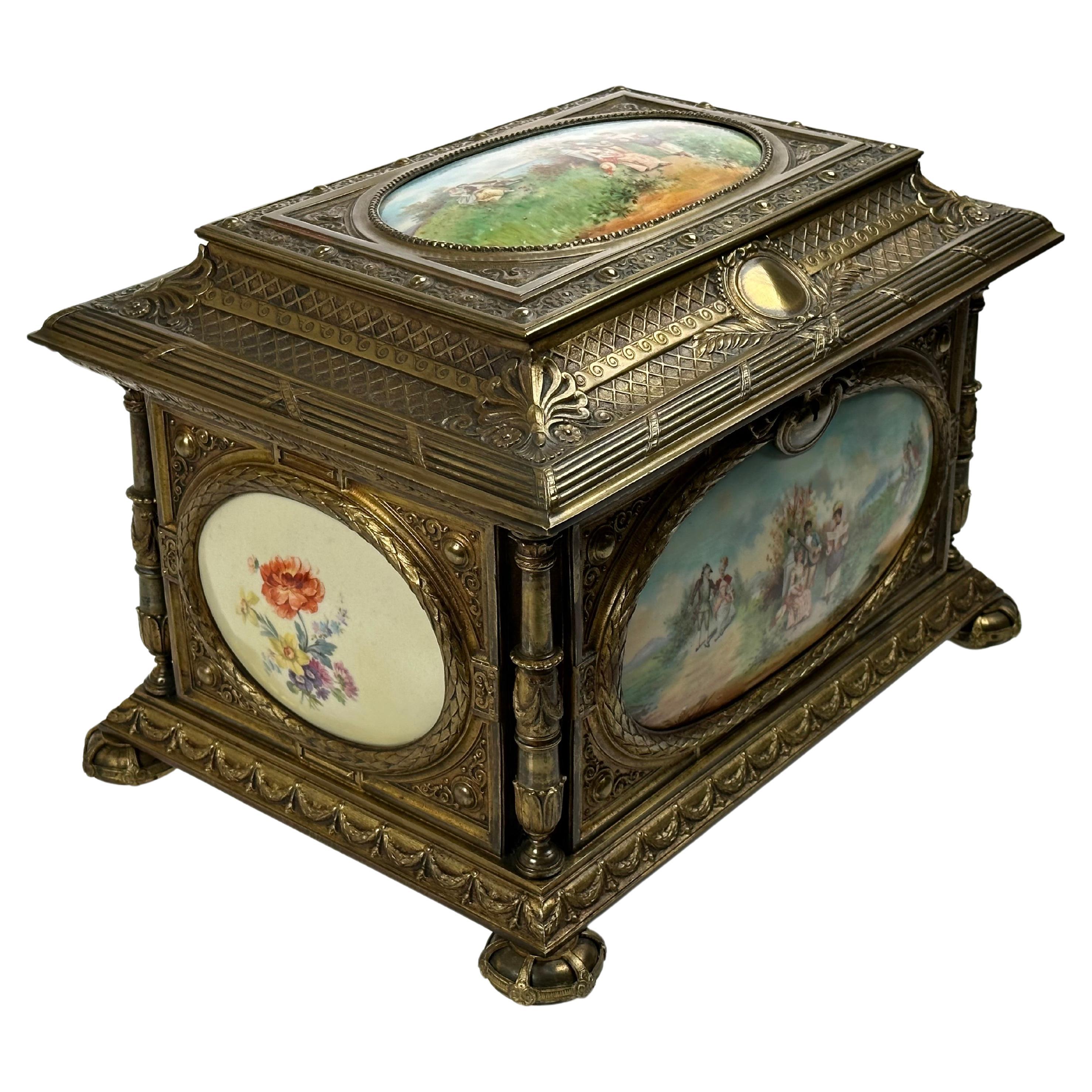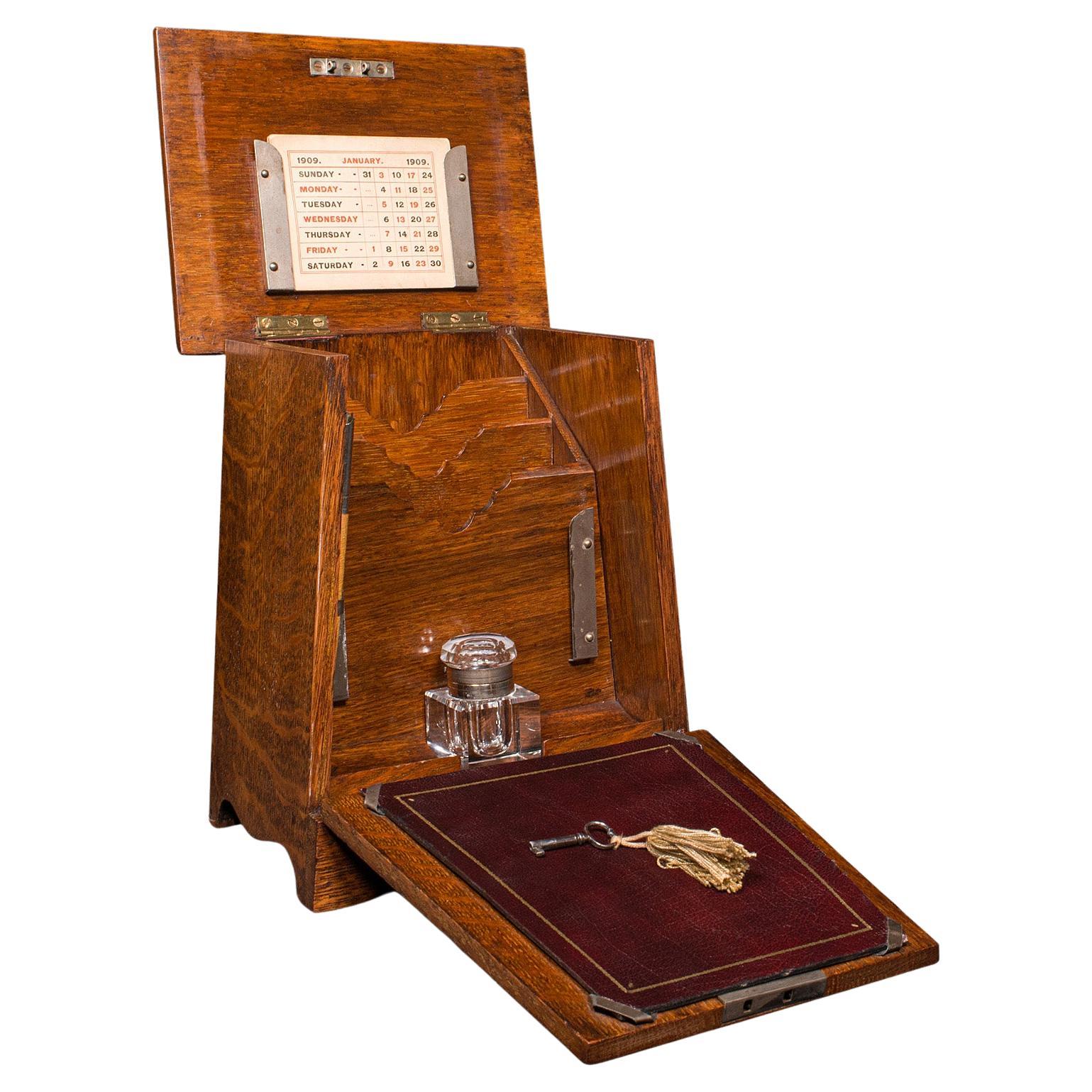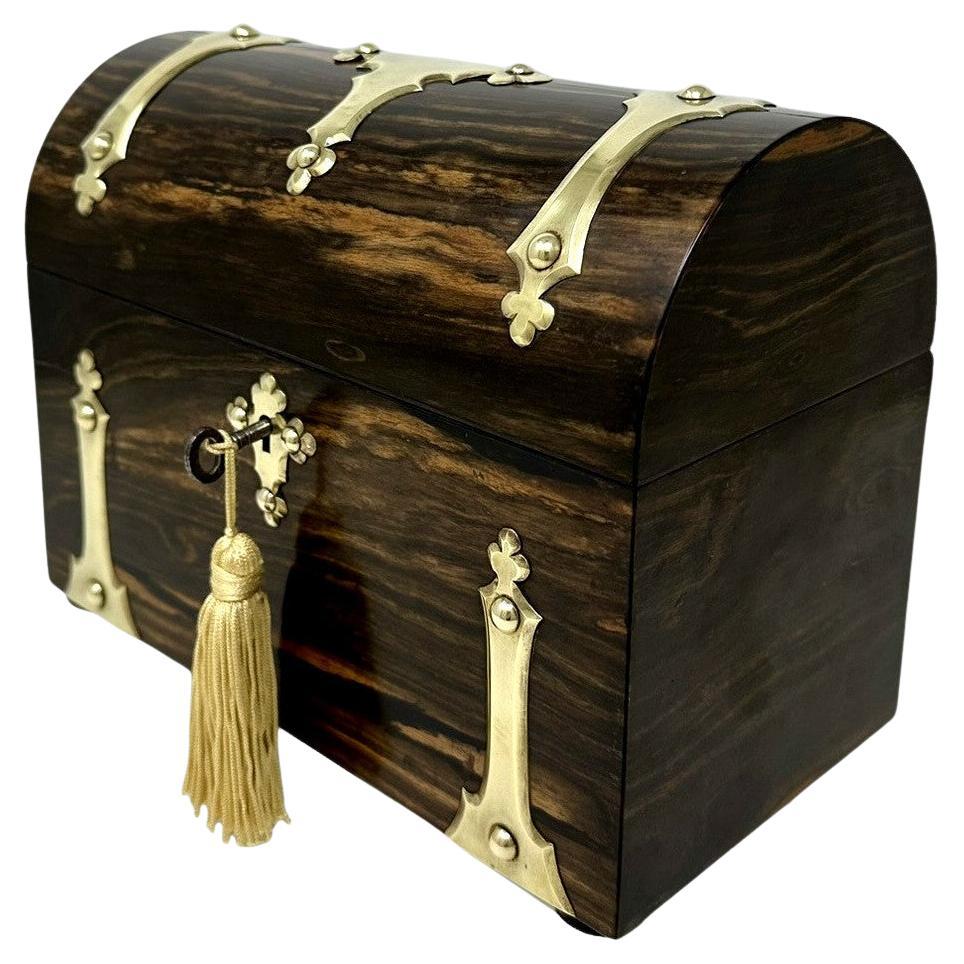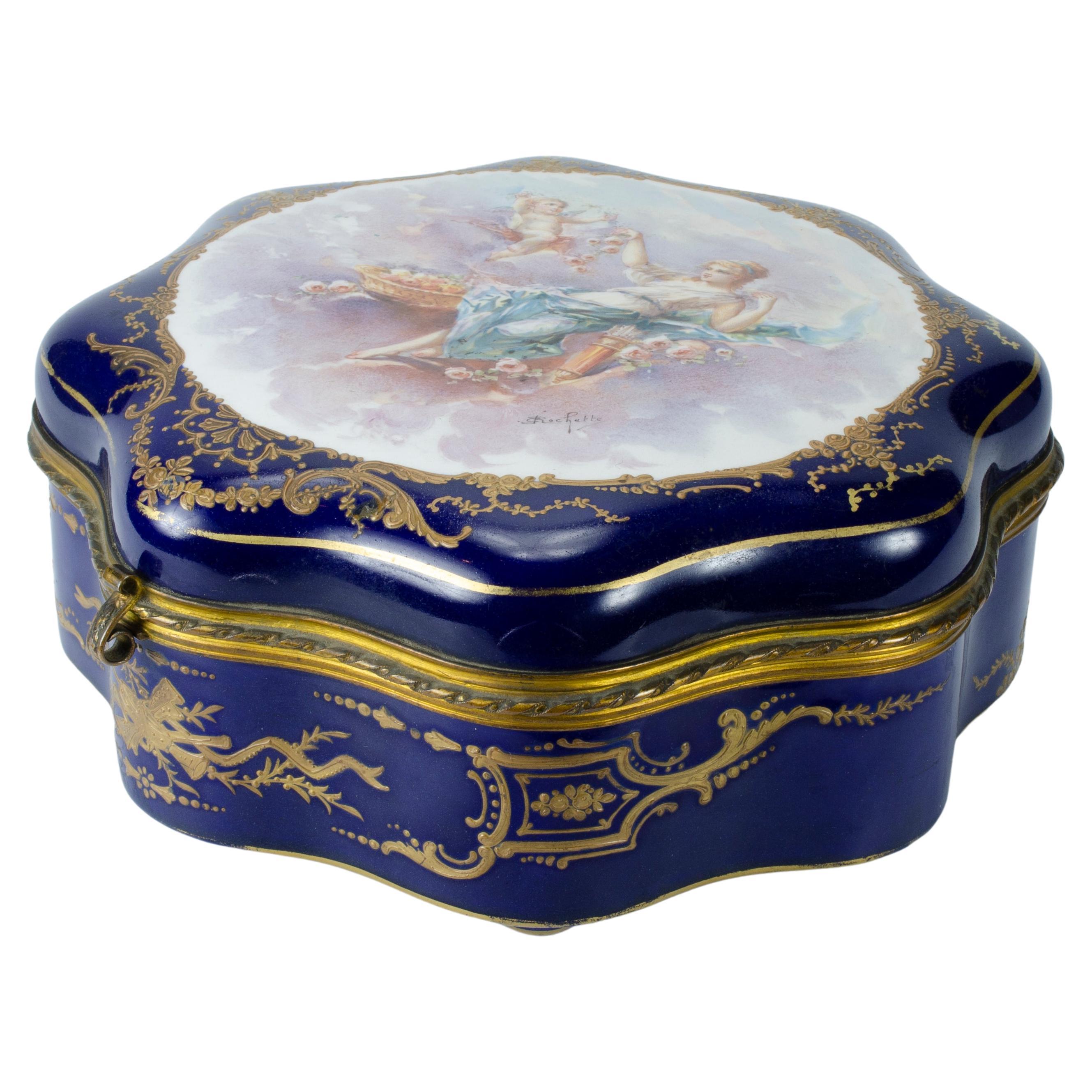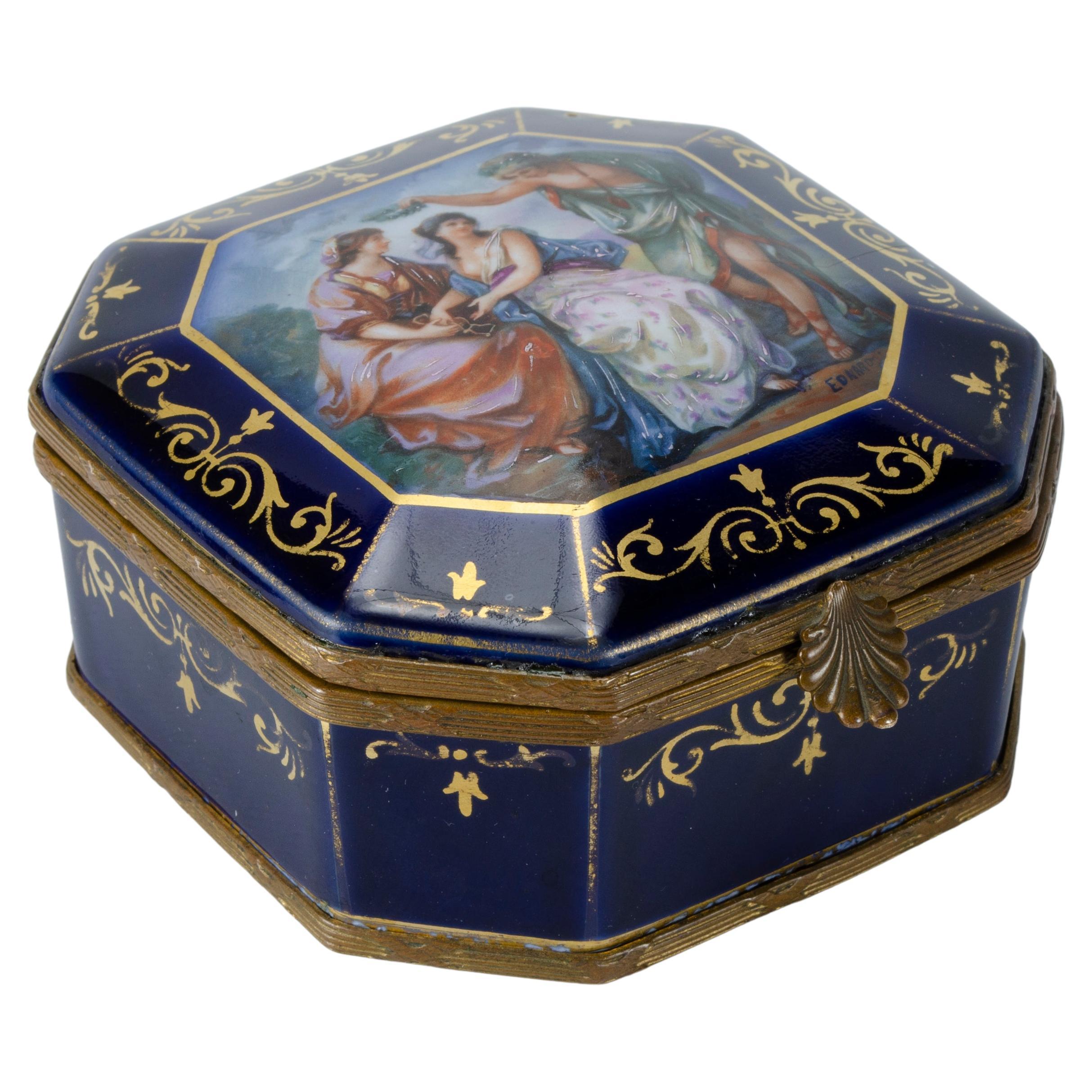Items Similar to Antique Sevres Porcelain Desktop Correspondence Casket Stationery Box
Video Loading
Want more images or videos?
Request additional images or videos from the seller
1 of 19
Antique Sevres Porcelain Desktop Correspondence Casket Stationery Box
About the Item
This is an absolutely fabulous antique French Ormolu and Sèvres Porcelain desktop correspondence casket, circa 1870 in date.
Of rectangular form, the front top and sides feature beautiful parcel gilt heightened and jeweled Sèvres Porcelain panels on bleu celeste ground. The large top panel depicting a period costumed mother and child in a beautiful garden with a gilt and red jeweled border, and the other panels with delightful floral motifs with gilt borders.
The top opens to reveal a sumptuous sky blue silk lined interior with various divisions. The rear of the casket is of gilded ormolu with beautiful engraved floral decoration, and the casket is raised on stunning dragon's paw scroll feet.
Complete with original working lock and key.
This item is of superb quality is incredibly rare and will instantly enhance any desktop.
Condition:
In really excellent condition, the porcelain and ormolu having been cleaned in our workshops. With no chips, cracks or signs of repair, please see photos for confirmation.
Dimensions in cm:
Height 20 x width 29 x depth 19
Dimensions in inches:
Height 7.9 x width 11.4 x depth 7.5
Sèvres Porcelain
traces its roots in France to early craftsmen who had small manufacturing operations in such places as Lille, Rouen. St. Cloud, and most notably Chantilly. It is from Chantilly that a cadre of workers migrated to the Chateau de Vincennes near Paris to form a larger porcelain manufactory in 1738.
French King Louis XV, perhaps inspired by his rumored relationship with mistress Madame de Pompadour, took an intense interest in porcelain and moved the operation in 1756 to even larger quarters in the Paris suburb of Sevres. Sèvres was also conveniently near the home of Madame de Pompadour and the King's own Palace at Versailles.
From the outset the king's clear aim was to produce Sèvres Porcelain that surpassed the established Saxony works of Meissen and Dresden. Though the French lacked an ample supply of kaolin, a required ingredient for hard-paste porcelain (pate dure), their soft-paste porcelain (pate tendre) was fired at a lower temperature and was thus compatible with a wider variety of colors and glazes that in many cases were also richer and more vivid. Unglazed white Sèvres Porcelain "biscuit" figurines were also a great success. However, soft-paste Sèvres Porcelain was more easily broken. Therefore, early pieces of Sèvres Porcelain that remain intact have become rare indeed.
The Sèvres Porcelain manufactory always seemed to be in dire financial straits despite the incredibly fine works it produced. In fact, the king's insistence that only the finest items be created may have contributed to the difficulties. Only a limited number of European nobility could afford the extravagant prices demanded for such works. King Louis XV and eventually his heir, the ill-fated Louis XVI, were obliged to invest heavily in the enterprise. Ultimately, the Sèvres Porcelain Factory produced items under the name of "Royal" and thus the well-known Sèvres mark was born. King Louis XV even mandated laws that severely restricted other porcelain production in France so as to retain a near monopoly for his Sèvres Porcelain. The king even willingly became chief salesman for the finest of his products, hosting an annual New Year's Day showing for French nobility in his private quarters at Versailles. He eagerly circulated among potential buyers, pitching the merits of ownership and policing the occasional light-fingered guest.
Sèvres Porcelain may have indeed given the makers of Meissen and Dresden a run for their money by the end of the 18th century but for the French Revolution. By 1800, the Sèvres Porcelain Works were practically out of business due to the economic devastation of the new French Republic.
About the time when Napoleon Bonaparte named himself Emperor of France (1804), a new director was named for the Sèvres Porcelain Manufactory. Alexandre Brongniart, highly educated in many fields, resurrected Sèvres Porcelain. Soft-paste porcelain was eliminated altogether thanks to the earlier discovery of kaolin near Limoges. For four decades until his death, Brongniart presided over monumental progress for Sèvres Porcelain, catering not only to Napoleon himself, but at last to include the more financially profitable mid-priced market in the emerging middle class.
Ormolu, (from French 'or moulu', signifying ground or pounded gold) is an 18th century English term for applying finely ground, high-carat gold in a mercury amalgam to an object of bronze. The mercury is driven off in a kiln leaving behind a gold-colored veneer known as 'gilt bronze'.
The manufacture of true ormolu employs a process known as mercury-gilding or fire-gilding, in which a solution of nitrate of mercury is applied to a piece of copper, brass, or bronze, followed by the application of an amalgam of gold and mercury. The item was then exposed to extreme heat until the mercury burned off and the gold remained, adhered to the metal object.
After circa 1830 because legislation had outlawed the use of mercury other techniques were used instead. Electroplating is the most common modern technique. Ormolu techniques are essentially the same as those used on silver, to produce silver-gilt.
- Dimensions:Height: 7.88 in (20 cm)Width: 11.42 in (29 cm)Depth: 7.49 in (19 cm)
- Materials and Techniques:
- Place of Origin:
- Period:
- Date of Manufacture:circa 1870
- Condition:
- Seller Location:London, GB
- Reference Number:
About the Seller
5.0
Platinum Seller
These expertly vetted sellers are 1stDibs' most experienced sellers and are rated highest by our customers.
Established in 1983
1stDibs seller since 2012
1,204 sales on 1stDibs
Typical response time: <1 hour
Associations
LAPADA - The Association of Arts & Antiques Dealers
- ShippingRetrieving quote...Ships From: London, United Kingdom
- Return PolicyA return for this item may be initiated within 14 days of delivery.
More From This SellerView All
- Antique French Sevres Porcelain and Ormolu Jewellery Casket 19th CenturyLocated in London, GBThis is a fabulous antique French Ormolu and Sevres Porcelain jewellery casket, circa 1860 in date. This magnificent casket is rectangular in shape with the top and each side except...Category
Antique 1860s Jewelry Boxes
MaterialsOrmolu
- Antique Coromandel Gothic Revival Gilt Brass Strapwork Stationery BoxLocated in London, GBThis is a lovely antique Victorian Gothic Revival gilt brass strapwork mounted Coromandel stationery box, circa 1870 in date. This delightful antique writing slope has a hinged se...Category
Antique 1870s English Gothic Revival Decorative Boxes
MaterialsBrass
- Antique Figured Coromandel Brass Box / Casket 19th CenturyLocated in London, GBThis is a magnificent antique brass bound coromandel Victorian Gothic Revival casket by Parkins and Gotto, 24 & 25 Oxford Street, London, circa 1860 in date. The rectangular box fe...Category
Antique 1860s English Victorian Decorative Boxes
MaterialsBrass
- Antique Pierced Brass Palais Royal Porcelain Mounted Casket, 19th CLocated in London, GBThis is a stunning antique 19th century French Palais Royal pierced brass and porcelain mounted domed rectangular table casket , Circa 1870 in date...Category
Antique 1870s French Decorative Boxes
MaterialsBrass
- Antique Huge French Amboyna Porcelain Cameo Writing Casket 19th CLocated in London, GBA French ormolu and porcelain cameo mounted amboyna writing box, circa 1860 in date. The rectangular casket features a lid with a central floral hand painted porcelain panel, cross...Category
Antique 1860s Decorative Boxes
MaterialsOrmolu
- Antique Limoges Royal Blue Ormolu Mounted Casket Box 19h CenturyLocated in London, GBThis is a beautiful antique French Limoges ormolu mounted rectangular bombe' shaped table casket, circa 1870 in date and bearing the Limoges marks on the underside. The Royal Blue c...Category
Antique 1870s French Decorative Boxes
MaterialsOrmolu
You May Also Like
- A Large French Antique Sevres Style Porcelain & Gilt Bronze Box CasketBy Manufacture Nationale de SèvresLocated in Los Angeles, CAAdorned with five painted panels depicting delicate floral motifs and classical scenes, this piece showcases the hallmark elegance and artistry of Sevres porcelain. Sevres porcelain...Category
Antique Late 19th Century French Jewelry Boxes
MaterialsBronze
- Antique Desktop Stationery Box, English, Oak, Arts & Crafts, Victorian, C.1890Located in Hele, Devon, GBThis is an antique desktop stationery box. An English, oak correspondence case in Arts & Crafts taste, dating to the late Victorian period, circa 1890. Striking Victorian craftsmans...Category
Antique Late 19th Century British Arts and Crafts Decorative Boxes
MaterialsLeather, Oak
- Antique Victorian Coromandel Brass Wooden Letters Stationery Writing Box CasketLocated in Dublin, IrelandAbsolutely stunning early Victorian well figured Coromandel Stationery Casket of museum quality and in outstanding condition. Mid to late Nineteenth Century, of English origin. Th...Category
Antique Mid-19th Century English Victorian Desk Sets
MaterialsBrass
- Antique Victorian Coromandel Brass Wooden Letters Stationery Casket Box BetjemanLocated in Dublin, IrelandAbsolutely stunning early Victorian well figured Coromandel Stationery Casket of museum quality and in outstanding condition. Mid Nineteenth Century. Made in England by G. Betjemann....Category
Antique Mid-19th Century Irish Victorian Desk Sets
MaterialsBrass
- Sevres Porcelain BoxBy Manufacture Nationale de SèvresLocated in Buenos Aires, ArgentinaSevres porcelain box octagonal format Hand painted and signed on its base perfect condition Origin France Circa 1900 its mount is gilded bronze.Category
Antique Early 1900s French Neoclassical Decorative Boxes
MaterialsBronze
- Sevres Porcelain BoxBy Manufacture Nationale de SèvresLocated in Buenos Aires, ArgentinaSevres porcelain box Origin France Circa 1900 Interior decoration (flowers) bronze mount hand painted box.Category
Antique Early 1900s French Neoclassical Decorative Boxes
MaterialsBronze
